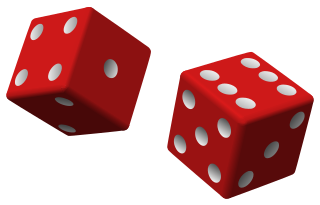A pseudorandom number generator (PRNG), also known as a deterministic random bit generator (DRBG), is an algorithm for generating a sequence of numbers whose properties approximate the properties of sequences of random numbers. The PRNG-generated sequence is not truly random, because it is completely determined by an initial value, called the PRNG's seed. Although sequences that are closer to truly random can be generated using hardware random number generators, pseudorandom number generators are important in practice for their speed in number generation and their reproducibility.

A linear congruential generator (LCG) is an algorithm that yields a sequence of pseudo-randomized numbers calculated with a discontinuous piecewise linear equation. The method represents one of the oldest and best-known pseudorandom number generator algorithms. The theory behind them is relatively easy to understand, and they are easily implemented and fast, especially on computer hardware which can provide modular arithmetic by storage-bit truncation.

A stream cipher is a symmetric key cipher where plaintext digits are combined with a pseudorandom cipher digit stream (keystream). In a stream cipher, each plaintext digit is encrypted one at a time with the corresponding digit of the keystream, to give a digit of the ciphertext stream. Since encryption of each digit is dependent on the current state of the cipher, it is also known as state cipher. In practice, a digit is typically a bit and the combining operation is an exclusive-or (XOR).
In computing, a linear-feedback shift register (LFSR) is a shift register whose input bit is a linear function of its previous state.
A cryptographically secure pseudorandom number generator (CSPRNG) or cryptographic pseudorandom number generator (CPRNG) is a pseudorandom number generator (PRNG) with properties that make it suitable for use in cryptography. It is also loosely known as a cryptographic random number generator (CRNG).
In cryptography, the shrinking generator is a form of pseudorandom number generator intended to be used in a stream cipher. It was published in Crypto 1993 by Don Coppersmith, Hugo Krawczyk, and Yishay Mansour.
A key generator is a protocol or algorithm that is used in many cryptographic protocols to generate a sequence with many pseudo-random characteristics. This sequence is used as an encryption key at one end of communication, and as a decryption key at the other. One can implement a key generator in a system that aims to generate, distribute, and authenticate keys in a way that without the private key, one cannot access the information in the public end.
In theoretical computer science and cryptography, a pseudorandom generator (PRG) for a class of statistical tests is a deterministic procedure that maps a random seed to a longer pseudorandom string such that no statistical test in the class can distinguish between the output of the generator and the uniform distribution. The random seed itself is typically a short binary string drawn from the uniform distribution.
A pseudorandom binary sequence (PRBS), pseudorandom binary code or pseudorandom bitstream is a binary sequence that, while generated with a deterministic algorithm, is difficult to predict and exhibits statistical behavior similar to a truly random sequence. PRBS generators are used in telecommunication, such as in analog-to-information conversion, but also in encryption, simulation, correlation technique and time-of-flight spectroscopy. The most common example is the maximum length sequence generated by a (maximal) linear feedback shift register (LFSR). Other examples are Gold sequences, Kasami sequences and JPL sequences, all based on LFSRs.
A self-shrinking generator is a pseudorandom generator that is based on the shrinking generator concept. Variants of the self-shrinking generator based on a linear-feedback shift register (LFSR) are studied for use in cryptography.
A nonlinear-feedback shift register (NLFSR) is a shift register whose input bit is a non-linear function of its previous state.
Grain is a stream cipher submitted to eSTREAM in 2004 by Martin Hell, Thomas Johansson and Willi Meier. It has been selected for the final eSTREAM portfolio for Profile 2 by the eSTREAM project. Grain is designed primarily for restricted hardware environments. It accepts an 80-bit key and a 64-bit IV. The specifications do not recommend a maximum length of output per pair. A number of potential weaknesses in the cipher have been identified and corrected in Grain 128a which is now the recommended cipher to use for hardware environments providing both 128bit security and authentication.

Random number generation is a process by which, often by means of a random number generator (RNG), a sequence of numbers or symbols that cannot be reasonably predicted better than by random chance is generated. This means that the particular outcome sequence will contain some patterns detectable in hindsight but impossible to foresee. True random number generators can be hardware random-number generators (HRNGs), wherein each generation is a function of the current value of a physical environment's attribute that is constantly changing in a manner that is practically impossible to model. This would be in contrast to so-called "random number generations" done by pseudorandom number generators (PRNGs), which generate numbers that only look random but are in fact pre-determined—these generations can be reproduced simply by knowing the state of the PRNG.
In computational complexity theory and cryptography, the existence of pseudorandom generators is related to the existence of one-way functions through a number of theorems, collectively referred to as the pseudorandom generator theorem.
A randomness test, in data evaluation, is a test used to analyze the distribution of a set of data to see whether it can be described as random (patternless). In stochastic modeling, as in some computer simulations, the hoped-for randomness of potential input data can be verified, by a formal test for randomness, to show that the data are valid for use in simulation runs. In some cases, data reveals an obvious non-random pattern, as with so-called "runs in the data". If a selected set of data fails the tests, then parameters can be changed or other randomized data can be used which does pass the tests for randomness.

Xorshift random number generators, also called shift-register generators, are a class of pseudorandom number generators that were invented by George Marsaglia. They are a subset of linear-feedback shift registers (LFSRs) which allow a particularly efficient implementation in software without the excessive use of sparse polynomials. They generate the next number in their sequence by repeatedly taking the exclusive or of a number with a bit-shifted version of itself. This makes execution extremely efficient on modern computer architectures, but it does not benefit efficiency in a hardware implementation. Like all LFSRs, the parameters have to be chosen very carefully in order to achieve a long period.
Correlation attacks are a class of cryptographic known-plaintext attacks for breaking stream ciphers whose keystreams are generated by combining the output of several linear-feedback shift registers (LFSRs) using a Boolean function. Correlation attacks exploit a statistical weakness that arises from the specific Boolean function chosen for the keystream. While some Boolean functions are vulnerable to correlation attacks, stream ciphers generated using such functions are not inherently insecure.
In sequence design, a Feedback with Carry Shift Register is the arithmetic or with carry analog of a linear-feedback shift register (LFSR). If is an integer, then an N-ary FCSR of length is a finite state device with a state consisting of a vector of elements in and an integer . The state change operation is determined by a set of coefficients and is defined as follows: compute . Express s as with in . Then the new state is . By iterating the state change an FCSR generates an infinite, eventually periodic sequence of numbers in .
In 1997, Moni Naor and Omer Reingold described efficient constructions for various cryptographic primitives in private key as well as public-key cryptography. Their result is the construction of an efficient pseudorandom function. Let p and l be prime numbers with l |p−1. Select an element g ∈ of multiplicative order l. Then for each (n+1)-dimensional vector a = (a0,a1, ..., an)∈ they define the function
KISS (Keep it Simple Stupid) is a family of pseudorandom number generators introduced by George Marsaglia. Starting from 1998 Marsaglia posted on various newsgroups including sci.math, comp.lang.c, comp.lang.fortran and sci.stat.math several versions of the generators. All KISS generators combine three or four independent random number generators with a view to improving the quality of randomness. KISS generators produce 32-bit or 64-bit random integers, from which random floating-point numbers can be constructed if desired. The original 1993 generator is based on the combination of a linear congruential generator and of two linear feedback shift-register generators. It has a period 295, good speed and good statistical properties; however, it fails the LinearComplexity test in the Crush and BigCrush tests of the TestU01 suite. A newer version from 1999 is based on a linear congruential generator, a 3-shift linear feedback shift-register and two multiply-with-carry generators. It is 10–20% slower than the 1993 version but has a larger period 2123 and passes all tests in TestU01. In 2009 Marsaglia presented a version based on 64-bit integers (appropriate for 64-bit processors) which combines a multiply-with-carry generator, a Xorshift generator and a linear congruential generator. It has a period of around 2250 (around 1075).






